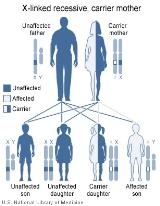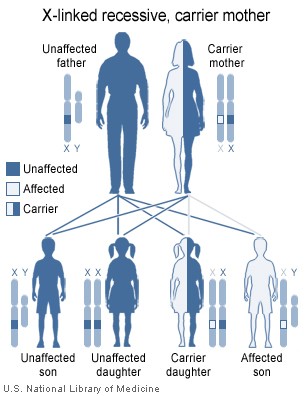
Kennedy disease
Encyclopedia
Kennedy's disease or X-linked Spinal and Bulbar Muscular Atrophy or Spinobulbar Muscular Atrophy (SBMA) or X-Linked Bulbo-Spinal Atrophy is an X-linked recessive, slow progressing, neurodegenerative disease associated with mutation of the androgen receptor
(AR). Because of its endocrine manifestations related to the impairment of the AR, it can be viewed as a variation of the disorders of the androgen insensitivity syndrome
(AIS). It is also related to other neurodegenerative diseases caused by similar mutations, such as Huntington's disease and the spinocerebellar ataxias. Kennedy's disease is named after W. R. Kennedy, a neurologist who was among the first to describe this disease.
 The androgen receptor
The androgen receptor
gene that is mutated in Kennedy's disease is located on the X chromosome
, and the effects of the mutation may be androgen-dependent, thus only males are fully affected. Females are rarely affected; female carriers tend to have a relatively mild expression of the disease if they show symptoms at all.
of the androgen receptor gene (trinucleotide repeats). The CAG repeat encodes a polyglutamine tract
in the androgen receptor protein. The greater the expansion of the CAG repeat, the earlier the disease onset and more severe the disease manifestations. The repeat expansion likely causes a toxic gain of function in the receptor protein, since loss of receptor function in androgen insensitivity syndrome
does not cause motor neuron degeneration. KD may share mechanistic features with other disorders that are caused by polyglutamine expansion, such as Huntington's disease
. There is currently no treatment or cure for Kennedy's disease.
It is a lower motor neuron
disease.
Ages of onset and severity of manifestations in affected males vary from adolescence to old age, but most commonly develop in middle adult life. The latest onset was described in a male of 84 years of age. KD does not usually compromise longevity. The syndrome has neuromuscular and endocrine manifestations.
Neurological:
Muscular:
Endocrine
Miscellaneous Characteristics:
(ALS, also Lou Gehrig's disease).
Androgen receptor
The androgen receptor , also known as NR3C4 , is a type of nuclear receptor that is activated by binding of either of the androgenic hormones testosterone or dihydrotestosterone in the cytoplasm and then translocating into the nucleus...
(AR). Because of its endocrine manifestations related to the impairment of the AR, it can be viewed as a variation of the disorders of the androgen insensitivity syndrome
Androgen insensitivity syndrome
Androgen insensitivity syndrome is a condition that results in the partial or complete inability of the cell to respond to androgens. The unresponsiveness of the cell to the presence of androgenic hormones can impair or prevent the masculinization of male genitalia in the developing fetus, as...
(AIS). It is also related to other neurodegenerative diseases caused by similar mutations, such as Huntington's disease and the spinocerebellar ataxias. Kennedy's disease is named after W. R. Kennedy, a neurologist who was among the first to describe this disease.
Genetics

Androgen receptor
The androgen receptor , also known as NR3C4 , is a type of nuclear receptor that is activated by binding of either of the androgenic hormones testosterone or dihydrotestosterone in the cytoplasm and then translocating into the nucleus...
gene that is mutated in Kennedy's disease is located on the X chromosome
X chromosome
The X chromosome is one of the two sex-determining chromosomes in many animal species, including mammals and is common in both males and females. It is a part of the XY sex-determination system and X0 sex-determination system...
, and the effects of the mutation may be androgen-dependent, thus only males are fully affected. Females are rarely affected; female carriers tend to have a relatively mild expression of the disease if they show symptoms at all.
Pathophysiology
As reported in 1991, Kennedy's disease is caused by expansion of a CAG repeat in the first exonExon
An exon is a nucleic acid sequence that is represented in the mature form of an RNA molecule either after portions of a precursor RNA have been removed by cis-splicing or when two or more precursor RNA molecules have been ligated by trans-splicing. The mature RNA molecule can be a messenger RNA...
of the androgen receptor gene (trinucleotide repeats). The CAG repeat encodes a polyglutamine tract
Polyglutamine tract
A polyglutamine tract or polyQ tract is a portion of a protein consisting of a sequence of several glutamine units. A tract typically consists of about 10 to a few hundred such units....
in the androgen receptor protein. The greater the expansion of the CAG repeat, the earlier the disease onset and more severe the disease manifestations. The repeat expansion likely causes a toxic gain of function in the receptor protein, since loss of receptor function in androgen insensitivity syndrome
Androgen insensitivity syndrome
Androgen insensitivity syndrome is a condition that results in the partial or complete inability of the cell to respond to androgens. The unresponsiveness of the cell to the presence of androgenic hormones can impair or prevent the masculinization of male genitalia in the developing fetus, as...
does not cause motor neuron degeneration. KD may share mechanistic features with other disorders that are caused by polyglutamine expansion, such as Huntington's disease
Huntington's disease
Huntington's disease, chorea, or disorder , is a neurodegenerative genetic disorder that affects muscle coordination and leads to cognitive decline and dementia. It typically becomes noticeable in middle age. HD is the most common genetic cause of abnormal involuntary writhing movements called chorea...
. There is currently no treatment or cure for Kennedy's disease.
It is a lower motor neuron
Lower motor neuron
Lower motor neurons are the motor neurons connecting the brainstem and spinal cord to muscle fibers, bringing the nerve impulses from the upper motor neurons out to the muscles...
disease.
Signs and symptoms
Kennedy's disease patients have muscle cramps and progressive weakness due to degeneration of motor neurons in the brain stem and spinal cord.Ages of onset and severity of manifestations in affected males vary from adolescence to old age, but most commonly develop in middle adult life. The latest onset was described in a male of 84 years of age. KD does not usually compromise longevity. The syndrome has neuromuscular and endocrine manifestations.
Neuromuscular
Early signs often include weakness of tongue and mouth muscles, fasciculations, and gradually increasing weakness of limb muscles with muscle wasting. In some cases, premature muscle fatigue begins in adolescence. Neuromuscular management is supportive, and the disease progresses very slowly but can eventually lead to extreme disability.Neurological:
- Bulbar signs: The bulbar muscles are those supplied by the motor nerves from the brain stem, which control swallowing, breathing, speech, and other functions of the throat. Bulbar signs are problems with these muscles.
- Lower motor neuron signs: The lower motor neurons are those in the brainstem and spinal cord that directly supply the muscles. Loss of lower motor neurons leads to weakness and wasting of the muscle.
- Primary sensory neuropathy: Loss of sensation and numbness, usually not noticeable.
- Intention tremor: Hand tremor with volitional effort.
- Babinski (plantar) response: When the bottom of the foot is scraped, the toes bend down. An abnormal response would be an upward movement of the toes indicating a problem with higher level (upper) motor neurons.
- Decreased or absent deep tendon reflexes: When a doctor taps the knee with his hammer little or nothing happens.
Muscular:
- Fasciculations: Twitching of muscles when at rest.
- Cramps: Large muscle spasms.
- Muscular atrophy: Loss of muscle bulk that occurs when the lower motor neurons do not stimulate the muscle adequately.
Endocrine
- Gynecomastia: breast enlargement.
- Impotence
- Erectile dysfunction
- Reduced fertility
- Low sperm count
- Testicular atrophy: Testicles become smaller and less functional.
Miscellaneous Characteristics:
- Late onset: Patients usually develop symptoms in the late 30's or later
- Symmetry of clinical signs: Muscles are usually affected symmetrically.
Homozygous females
Homozygous females, both of whose X chromosomes have a mutation leading to CAG expansion of the AR gene, have been reported to show only mild symptoms of muscle cramps and twitching. No endocrinopathy has been described.History
This disorder was first described by Dr. William R. Kennedy in 1968. In 1991 it was recognized that the AR is involved in the disease process. The disease is probably more common than originally thought. A study in Scandinavia suggested a prevalence of 1.3/8,500 making KD the most common form of motor neuron disease in the specific area studied; nobody had been diagnosed before 1995. It has been suggested that some men with KD may be misdiagnosed to have amyotrophic lateral sclerosisAmyotrophic lateral sclerosis
Amyotrophic lateral sclerosis , also referred to as Lou Gehrig's disease, is a form of motor neuron disease caused by the degeneration of upper and lower neurons, located in the ventral horn of the spinal cord and the cortical neurons that provide their efferent input...
(ALS, also Lou Gehrig's disease).

